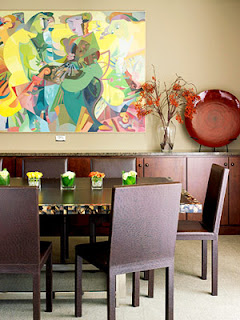Pairing the right paint color and lighting in a space can have fabulous results. The mood, the dimension, and certainly the ease of using a space are all set with color and light. Here is a quick guide for selecting a color that works well with your rooms.
 |
| A north facing bath seems brighter with a sunny yellow hue. |
Analyze your windows. Which way are they facing and which way is north? On sunny days, a south-facing room will be light most of the day whereas, the opposite is true if you’re in a room whose windows face north. Cooler colors - blues and greens - generally balance rooms with abundant sunshine. In rooms without direct sunlight, warmer colors - reds, yellows and oranges - brighten the room.
 |
| With blue natural lighting, the yellow undertones in paint and fabrics make a bright room, warm and inviting. |
What do you use the room for? When tasks are being done, lighter colors allow more light to be reflected throughout a space. Painting a sewing room or home office in light pastel tones or colors with a yellow undertone, will make the space seem brighter. If rooms are only used at night with lamplight - for entertaining and relaxing - then richer colors are in order. Do away with beige and tan and use rich brown, deep blue and greens, and even warm terra cotta and burgundy, For rooms used in the morning—like a breakfast nook— neutrals and whites look great in that clear light. For north facing spaces that are dark, adding yellow tones creates warmth and brightness. As above, if you want to tone down a sunny room, use neutrals or add colors with blue undertones.
 |
| This bold artwork called for a more neutral palette. |
Take inventory in the room. If you have a rug, or another large piece, it will affect every other color in the space. A large purple canvas might make a taupe wall look pink, so pay attention to adjacent colors and how they reflect colors on each other. The bulbs in your lighting will also change the way a color looks on the wall. Since incandescent bulbs are going to be eliminated due to poor energy consumption, and improved operating costs with LED and compact fluorescent bulbs, be sure to read the color rendering index on the package. White light from a bulb will 'cool' warm colors, so painting a room red that has white LED lighting will defect the effect. The same is true for using warm, yellow light in a cool toned room.
Test before painting for best results. Obtain a small sample of the color and paint it onto a SMALL WALL or faux finish board. Then, place the board in corners, in best light, and in dark areas of your space, and do a visual check. Don't paint swatches next to one another on the wall. First, you'll have too many colors adjacent to one another that will affect the overall appearance, and second, you will need to prime and cover so nothing shows through your final color selection. When in doubt, hire a color pro for an hour or two to help you define the perfect color for each space. The time spent is well spent when errors and re-dos are the alternate result!